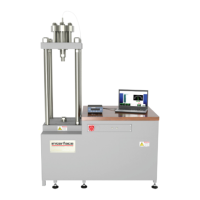7418 East Helm Drive • Scosdale, Arizona 85260 • 480.948.5555 • www.interfaceforce.com
Page 26 of 45
CALIBRATION SET POINT FILE CREATION
When a new calibraon sequence is desired or a calibraon standard is recalibrated, a new calibraon set
point le is required. Following is the instrucon for creang a le. When all of the required data has been
entered in the Device Under Test informaon screen, select either TENSION or COMPRESSION for the mode of
calibraon. The set point selecon screen will now be displayed (See gure 9). There are 3 dierent methods
of le creaon. Each is explained.
Using mV/V values from the standard calibraon cercate.
Follow these steps. (A typical 5 point, 5Klbf calibraon le is illustrated as an example).
1. Enter into the load column each of the ve (5) ascending and one (1) descending load points as they are
taken from the calibraon sheet of the standard. Make certain to use the same units as the standard
calibraon sheet (Klbf in the example).
2. Press the Enter key to get to the top of the next column. Enter the mV/V value for each set point from
the standard calibraon sheet. Make certain the entered values are for the desired mode, tension or
compression, and that the polarity of each value as listed is preserved.
3. When all of the values have been entered, click the Curve Fit Plot buon. The graph should show a
smooth curve with all points falling on the curve. If not, a keying error has been made and must be
corrected. If the graph is OK, click the Exit buon and then the Connue buon. The le can then be
saved under the desired le name.
Using coecients from the standard calibraon cercate.
1. This method is especially useful for creang set points that are not listed on the standard calibraon
cercate. Enter the desired loads in the load column. Make certain they are in the same units as the
standard calibraon cercate.
2. Select the polynomial degree of t.
3. Enter the coecient values from the calibraon cercate for the appropriate mode.
4. Click the “Compute Set Points” buon. The mV/V column will be completed automacally.

